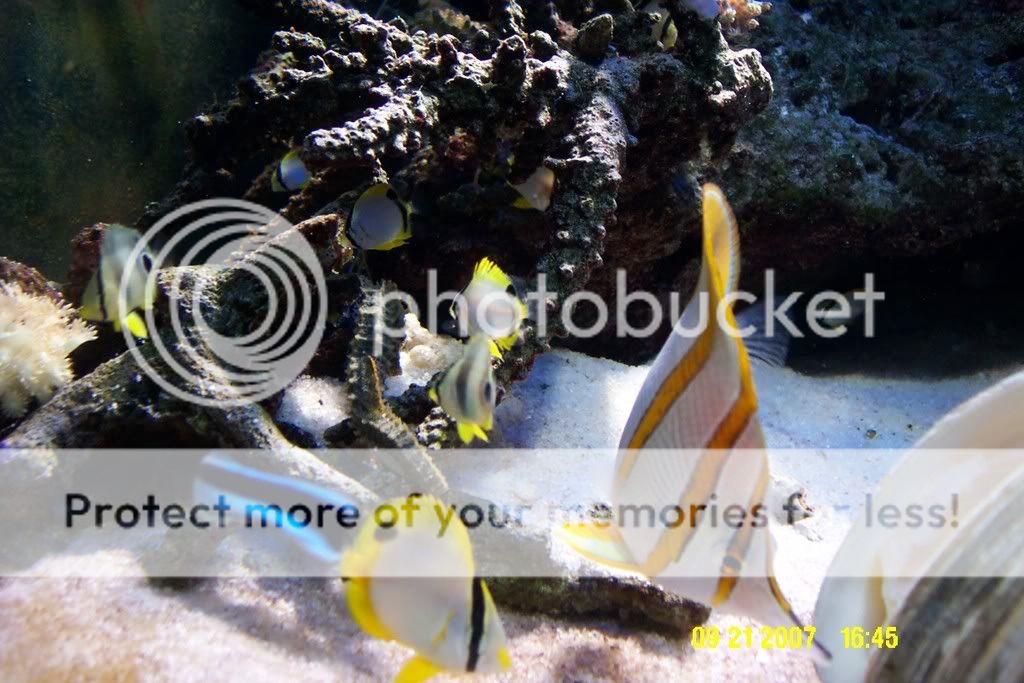After an arduous day of collecting myself and a few other reefers ended up with about 20 1" spotfin's. Some of them were as small as a half inch and a few were larger. I took a mix in sizes and after an hour in the tank they began to pick at the rocks. They looked at the cyclopeeze and mysis with interest but I don't think they ate the frozen food yet. I did see some of the smallest butterflies picking at the glass so I think they are eating the amphipods in the tank.
We spent a good five hours collecting and made at least 15 passes with the seine net in water up to our chests. PaulB would be proud. While walking backwards the trick was to keep a look out for the rather scarily large jelly fish in the water. During one pass we pulled out a pair of very angry blue crabs that were big enough to take off a toe. After that I was equally as nervous to walk through the eel grass and step on a crab as I was to get stung by a jelly fish. We were all wearing waterproof shoes or at least flip flops, there is no way you want to walk through the eel grass and rocks in bare feet. Also towards the end of the day it felt like something was biting my legs. It could have been the salt irritating some cuts form the eel grass, but it felt like something biting. Having seen some nasty looking isopods clinging to the net did not help my imagination at all. Just thinking of one latching on to my leg or some other part of me under the water was the final straw that made me stop collecting for the day. If you don't know what an isopod is have a look at this fun article,
http://www.reefs.org/library/article/clarke_shimek.html
The variety of fish we saw was really interesting. With every pass there were lots of brown pipefish, a few black seahorses, and tons of small greenish brown wrasses. None of which were kept as they need much cooler water than out tanks could provide. Other local fish were one good sized fluke, small groupers, northern blowfish, lots of small black fish, and many baby barracudas. None of these were kept either as some are game fish and come under strict DEC laws. There were always silversides in each catch as well. At one point we netted a small shoal of them which were collected as food for some of the reefers tanks.
What we were really after were the tropical strays, which ended up being the butterfly fish and a few spiny box fish.I mentioned in another post that the coolest fish of the day were some coronet's we caught in one of the first passes. They are beautiful looking fish that appear related to the trumpet fish. They have long yellowish/green bodies with electric blue spots on their backs. I wish we could have saved them, however they grow to a huge size in the wild and will only eat small live fish, not easy requirements to fill for the average hobbyist. If we catch some in the future I was thinking of calling Atlantis Marine World and seeing if they wanted them. I felt bad releasing them knowing they were only going to die in the winter.
I was hoping to find some angel fish, but that did not happen. I'll try a different location in the next two weeks and hopefully some will appear. A blue tang was spotted but not saved. Someone yelled out they saw a blue angelfish and the hunt was on, later it was seen swimming away and the angelfish sighting was changed to a tang. All in all it was a fun way to spend one of the last days of summer at the beach, saving tropical fish, getting sunburned and having a nature trip all rolled into one. I hope to have good news to report on the butterflies growth. I'll be keeping some for myself and giving a few to other trusted reef keepers. As stated previously these are not fish to collect and keep if all you do is feed your fish flake food, which is not something you should be doing anyway.







